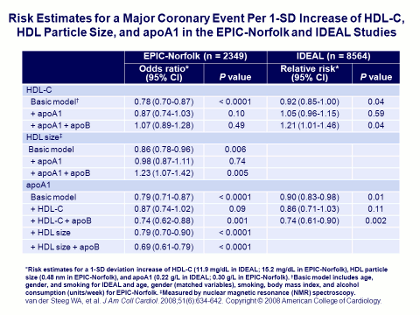Rosenson - Figure 8 - EPIC-Norfolk and IDEAL Text
To counter these limitations with direct HDL cholesterol measurements, many people perceive that measuring apolipoprotein A-I (apoA-I), the major protein on HDL particles, is a better predictor of CVD risk. Since apoA-I interacts with the ABCA1 transporter on the macrophage and facilitates cholesterol efflux from macrophage foam cells, it is perceived as a better biomarker of cardiovascular risk; however, it turns out that in prospective population studies and clinical trials of lipid modifying therapy, apoA-I is no better than serum HDL cholesterol level as a predictor of risk.
If we look at the EPIC Norfolk Study and the IDEAL trial,[45] the risk associated with high serum levels of HDL cholesterol is reduced by about 22%; on the other hand, if we look at the apoA-I, the CVD risk is reduced by 21% – and statistically, those numbers are the same. If we then do the reverse and substitute apoA-I into models based on HDL cholesterol, the relationship diminishes slightly; in models where apoA-I is added first and then we add in HDL cholesterol, the relationship is diminished by the same amount. In other words, what this is telling us is that HDL cholesterol and apoA-I are giving comparable information with regards to risk prediction.
However, the important point is that if one adjusts for apoB, which is a surrogate for the LDL particle concentration, then the relationship between HDL cholesterol and incident CVD events disappears.
So again, we need to consider lipoprotein interactions in our risk prediction models in order to get a more broad-based complete perspective on HDL cholesterol related residual risk. Specifically, the inverse associations between elevated triglycerides and elevated LDL particle concentration may have important implications for cardiovascular risk.
J Clin Lipidol. 2011; 5(6).References
[45]van der Steeg WA, Holme I, Boekholdt SM, et al. High-density lipoprotein cholesterol, high-density lipoprotein particle size, and apolipoprotein A-I: significance for cardiovascular risk. J Am Coll Cardiol, 2008; 51:634-642.
